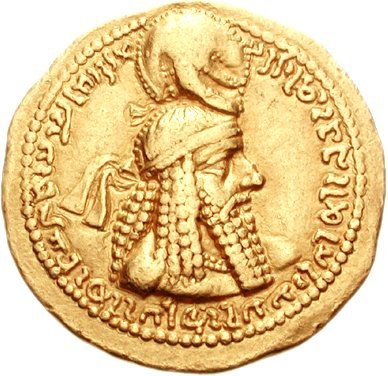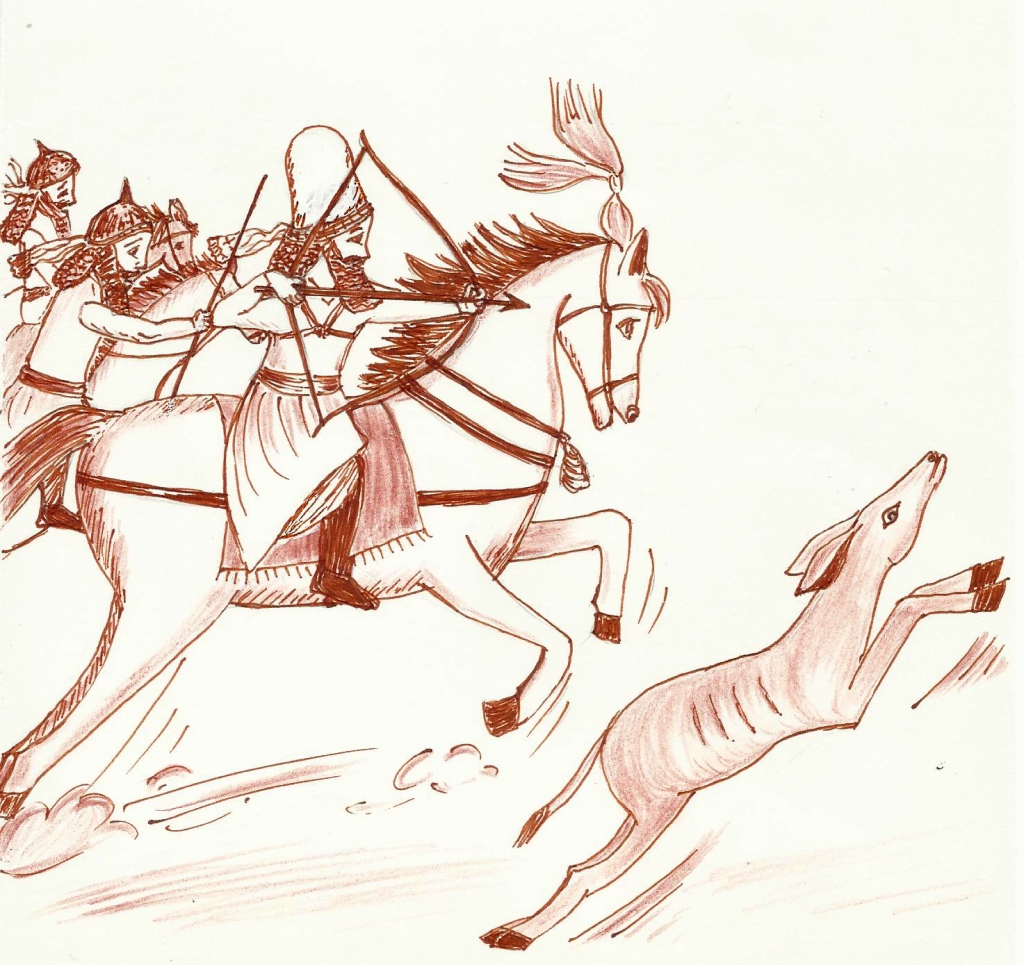
A gold coin of king Ardeshir Pāpakān
The Sasanian Empire, was founded by Ardeshir / Artakhshīr Bābegān/Pāpakān, referred to as Artaxerxes by the Romans, who had an illustrious ancestry. His maternal grand-father was Bābak and his father was Sāsān.
Ardavan (Gk. Artabanus IV), the last Parthian emperor ruled over a vast kingdom which included Shiraz, Istakhra and Esfahan. Istakhra, situated in the province of Fars, was entrusted to Papak/Bābak a local administrator of royal lineage.
Sāsān was a member of a family which traced its descent from Kayanian and Achaemenian kings. He stayed in Istakhra and eked out his livelihood by tending cattle and looking after camels. When Sāsān was not able to make ends meet, he went to Bābak to seek livelihood. Bābak, struck by his royal looks, immediately appointed him as a care-taker of his horses. Impressed by his sincerity and work, he later promoted him as the supervisor of the royal stables.
Once, on three successive nights, Bābak saw three different dreams. In the first dream, he saw the sun shining over the head of Sāsān, giving light to the whole world. On the second night, Bābak saw Sāsān riding an elephant with a sword in his hand, and people passing by bowing down to him with respect. On the third night, Bābak had another dream in which he saw the three spiritual fires of Ādar Gushasp, Ādar Khordad and Ādar Burzin Meher blazing high in the house of Sāsān, and exuding a sweet fragrance.

When Bābak asked his council of wise men to interpret the dreams, he was told that the person in the dream or his immediate descendant was destined to be an emperor.
Bābak summoned Sāsān and inquired about his ancestry. Reluctant on account of fear, Sāsān hesitated, but when Bābak assured him of his safety, he disclosed his royal ancestry. Highly touched by his nobility, Bābak gave Sāsān royal clothes and wealth, gifted him a palace and in due course married him to his daughter Gohar-āfrid.
In 180 CE, Sāsān was blessed with a son, who resembled his royal ancestors. He was named Ardeshir. As Bābak had no child, he raised up Ardeshir as his own son. Later the title Bābekān/Pāpakān was added to his name. He grew up to be a brilliant and brave young man. Soon he attained fame in Pars as an accomplished, virtuous and brave prince, well versed in arts, statecraft and military skills.
Ardavan summons Ardeshir
When Emperor Ardavan heard about Ardeshir, he summoned him to his palace in the capital city of Rae so that he can keep an eye over him, since he feared that a subordinate prince may gain greater power and glory.. As king Bābak was a subordinate of emperor Ardavan, he could not refuse. With a heavy heart, he sent Ardeshir to Ardavan, who kept him along with his own four sons and trained him in arts of warfare. Ardavan, always felt that Ardeshir was far superior then any of his princes, hence he always harboured feelings of insecurity.
Once, when Ardavan went hunting with his princes and Ardeshir, while chasing an onager (asian wild ass, known in Iran as gur-khar), they got separated. Ardeshir, who was the fastest among the lot, shot an arrow piercing the heart of the onager. When Ardavan caught up with them, he saw the skill with which the arrow was shot, and inquired about the identity of the archer. Ardeshir as well as and one of the princes claimed to have shot it. There was a quarrel between the two in which Ardeshir scorned the prince and called him a liar.

Ardavan unhappy with Ardeshir
Ardavan was angered by Ardeshir’s harsh words and as a punishment sent him to the royal stables and asked him to work and stay there. Ardeshir was greatly pained, as he knew that Ardavan had acted unjustly. His pride was wounded and he started to nurse a grudge against Ardavan. He wrote a letter to his grand-father Bābak about this. After reading the letter, Bābak replied, reprimanding Ardeshir for behaving rudely with the prince. He dispatched the letter along with ten thousand Dinars (gold coins).
Ardeshir felt comforted on receiving the letter, and merrily spent his time in enjoyment. He befriended Gulnar, a royal lady who was the chamber-maid at the king’s palace. Some sources claim that the lady was Arta-dukht, the daughter of Ardavan. Both of them saw each other daily and in due course started sharing sentiments of love and loyalty with each other.
After some time, Bābak passed away in Pars. Ardavan, instead of giving Ardehsir his rightful crown, instituted prince Bahman on the throne. When Ardeshir came to know of this, he was angry since he was the rightful heir. He harboured feelings of resentment and contemplated ways and means to get back the throne which was rightfully his.
On day, in the palace, when Ardavan was consulting soothsayers, he asked them about his future. He was told that a young man from a noble family who was in his service, would flee within three days and take over his throne. Ardavan was shocked on hearing this grim prognostication.
Ardeshir flees
Gulnar had overheard the prophecy of the soothsayers and conveyed it to Ardeshir. When Ardeshir heard about the prediction for the emperor, he realized that it was in consonance with his own plans. It gave him an impetus to flee Rae. He asked Gulnar whether she would help him to flee and accompany him if he fled, to which she readily agreed. At night, Gulnar brought some precious gems, made arrangements for two horses, and the two fled. Ardeshir kept a sword ready for their defense.
Emperor Ardavan was very fond of Gulnar. She used to wake him up every morning. Hence, he noticed the absence of Gulnar in the morning. On inquiring he was told that Gulnar and Ardeshir were not to be found and two horses, one white and the other black, were missing from the stable. Ardavan immediately realized that Gulnar had fled with Ardeshir.

Ardavan immediately set off with a few soldiers to look for them. On the way, he inquired whether anybody had seen a man and a woman on a black and a white horse pass by at dawn. He was told that such a couple had indeed passed by and were followed at a distance by a stately white sheep.
Ardavan inquired with his advisors about the white sheep. He was told that it symbolized potential royalty for the young man. If the sheep caught up with the person, it would mean that the person would become a great king and spell doom for Ardavan. A tired Ardavan, took some rest and then resumed his search for Ardeshir.
Ardeshir and Gulnar rode without halting. By afternoon their heads were reeling under the heat of the sun and their throats were parched with thirst. They stopped at a pond in order to take some rest. But before they could alight from their horses, two stately young men approached them, and told them not to get down, as they could not afford to lose a single minute. The duo heeded the advice and started riding ahead, and did not stop till the end of the day.
Ardavan was close behind them. In the evening when he reached a city, he once again inquired about the two. He was told that two such riders were seen moving towards Pars at dusk. They further added that a stately white sheep was swiftly running next to the man’s horse.
On inquiring with his advisor, Ardavan was told that luck was favouring the young man. He was told to ask his son Bahman in Pars, to try and find Ardeshir and not let him have the milk of the sheep, or else he would acquire the Khoreh (divine energy) and then nothing could stop him from being the Emperor of Iran.
Ardavan halted in a nearby city for the night and asked his soldiers to return. He wrote a letter to his son Bahman ruing about the escape of Ardeshir, the grim prognosis, and asked him to act fast.
By night Ardeshir had reached close to Istakhra. A fisherman recognized him on account of his royal looks and stately behavior. He informed the people, who recognized him and rallied round him. Ardeshir addressed them, “My dear people, you know what Alexander had done to our ancestors. When I, a descendant of the Kayanian prince Asfandyar, am alive, there is no reason why Ardavan should rule over us. If you agree with me, I will not allow anybody to occupy the throne.”
The people immediately agreed. A wise man from among them told Ardeshir, “Go ahead and fight Ardavan. You have our support. You may find it difficult. But once you have overpowered him, nobody will dare to stand against you.”
Encouraged by these words, Ardeshir proceeded towards Pars. When Bahman came to know about this, he assembled his army to counter Ardeshir.
Ardeshir gets an ally
Ardeshir got his first supporter and ally in Tabak/ Banāk, the elderly governor of Jarrom city. Initially Ardeshir was doubtful of Tabak’s sincerity as he used to be Ardavan’s supporter. However, later he was convinced of his genuineness.
Very soon more support poured in, and Ardeshir had an army of about fifty thousand young men. He thanked Ahura Mazda for this unexpected help. Assured of support, he proceeded to attack Bahman. However, he did not have to fight, as the king’s army surrendered and opened up the treasury. Ardeshir reached Pars and declared himself king of Pars in 208 CE, and gradually consolidated his position.

I read your content with great interest.
I am a third year student of Avasta-Pehlavi course run by Bombay Parsi Punchayet where your Avesta grammar book was our text book for 1st year.
Could you please throw some light on the language written on the Gold coin of Ardeshir Baabekaan? Also in which museum is it stored?
I appreciate the service you are doing to our community by making us aware of our religious and cultural heritage.
Thank you.
Regards
LikeLike
Dear Dr. Dilnavaz, Thanks for your kind words. The language on the Gold coin of Ardeshir Babekan is Inscriptional Middle Persian (Pahlavi), which can be regarded as the pre-cursor to Book Pahlavi. The largest collection of Sasanian coins are at the Hermitage in Russia. A sizeable number is also there in the British Museum, the National Museum of Tehran as well as the Kunsthistoriche Museum in Vienna. Regards.
well.
LikeLike